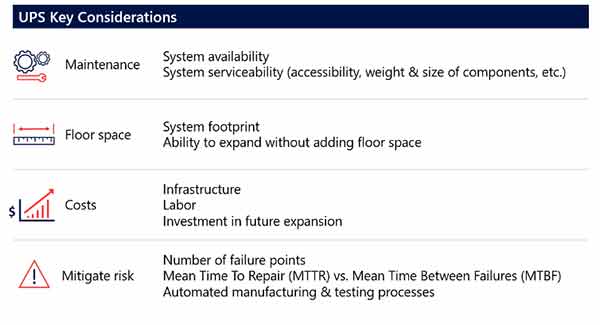Feature on Monolithic vs. Modular UPS Systems, and the benefits or disadvantages of both in terms of reliability, cost and simplicity.
By Luke Eiland, Service Manager, SolarEdge Critical Power Division
Increasing demand for reliable power, coupled with the growing use of essential electrical equipment and digitization, is driving up adoption of UPS systems. While data centers, hospitals, and manufacturers were among the first to adopt the technology, demand for UPS systems is expanding to other users such as research facilities, schools, or anywhere with critical power applications. Considering the high stakes associated with energy failure, what are the most important factors to consider when choosing such a system?
UPS System design boils down to two main types – monolithic or modular. The original UPS design, the monolithic system, is a solution made of single sub-systems including one static switch, one rectifier, one inverter etc. – but importantly, they have no intrinsic redundancy. The later developed modular UPS is, as the name suggests, made up of several smaller components that can be added or removed to scale the solution up or down. Looking at both UPS solutions, we will analyze the benefits of each in relation to three main decision criteria – cost, reliability and simplicity.
When making any investment, cost is always the primary consideration. When it comes to UPS systems, and if comparing systems of a similar power requirement, the traditional monolithic solution has the lower initial price tag. This is why, traditionally, it has been the solution of choice for organizations with smaller power requirements – especially if their needs are unlikely to change in the near future. However, for those businesses with larger power requirements or where increased flexibility is needed, there is more to consider.
While there are different model sizes of monolithic systems, there is less flexibility in terms of power capacity than with modular UPS. Subsequently, monolithic UPS users often end-up paying more for a system that’s larger than they need to reach their power requirements. Additionally, should their power requirements change, due to a lack of design flexibility, a whole new monolithic system is often required.
This is one of the strengths of modular UPS. To increase the capacity of your modular system, it’s as simple as buying additional power modules and slotting them into your existing rack. What’s more, should you have multiple modular UPS solutions at your facility, you can also swap modules from system to system to address changing load profiles – increasing efficiency savings and mitigating risk.
Designed to ensure that your power supply is reliable and uninterrupted, a UPS system must be extremely robust and reliable – obviously, this is critical when powering lifesaving medical equipment or other essential electrical devices.
Traditional monolithic systems feature a simple design. Consisting of fewer individual components, this means that there are less failure points in the system. Alternatively, modular UPS solutions spread the load over many more components. Which it could be argued, provides many more potential failure points. However, in a monolithic system, failure of one component could mean failure of the system as a whole. But in true modular units, if one module fails, it’s separated from the rest of the system and the other modules pick-up the slack to ensure continued operation/power. This is a key distinction between modular systems. Not all modular solutions are the same, and only ‘true modular’ UPS, like our own SolarEdge solutions, provide this functionality.
Like many things in life, being handmade is generally better, however UPS systems are not one of them. While large monolithic solutions are manufactured manually with the resulting risk of human error, smaller power modules for modular UPS systems are manufactured and tested utilizing automated solutions. This approach adds to reliability, with each of these smaller modules also being machine tested before shipping – something that’s not undertaken within the monolithic manufacturing process.
Thankfully, failure of a UPS system is uncommon, but replacing individual components as part of regular system maintenance is both expected and planned. Ensuring that your system remains operational, or that you have back-up power during those service intervals, can be a big issue with considerable consequences for your operation.
For this, modular UPS systems are relatively easy to maintain. In a true modular solution, each essential part is hot swappable and can be removed for maintenance or replaced while the system continues to run. Conversely, a monolithic system will likely need to be shut down for maintenance of core components, which means that you either lose your back-up facility during this period, or you have to switch to another system – essentially meaning that you need two units to provide the same service, with all the associated costs of purchasing, installing and maintaining two UPS devices. Now, some users also install two modular UPS systems for ultimate peace of mind, but this trend is beginning to change as depending on the load’s criticality, it’s often not necessary.
Crucially, and unlike the modular approach, if certain individual parts fail in a monolithic environment, the process of replacing them is often complex and time consuming, requiring a specialist UPS engineer representing additional downtime and cost.

Both UPS systems are reliable, but they employ totally different designs to provide different levels of flexibility and autonomy. For organizations with lower critical power application requirements, a monolithic solution will be both cheap to install and generally fit for purpose. But as we’ve explored, you could also be installing a system that’s larger and more expensive than you need, as well as being more costly to maintain in the long run. Plus, should your power requirements change, and you need to add more capacity, monolithic solutions don’t have the system flexibility to support you.
For organizations that require ultimate reliability and no downtime, a modular UPS system is very appealing – but on the face of it, they do look more expensive. But, when the total cost of ownership is calculated considering ease of maintenance, a smaller floorspace footprint and overall system flexibility, the modular argument becomes very compelling.

About SolarEdge Critical Power Division
SolarEdge is a global leader in smart energy and the world’s #1 solar inverter company in revenue with millions of systems installed in 133 countries. SolarEdge addresses a broad range of smart energy market segments through its PV, storage, UPS, EV charging, battery, electric vehicle powertrains, and grid service solutions.
SolarEdge’s Critical Power Division delivers innovative products and solutions that powers critical computers, storage, and machines in a broad range of sectors. With the accelerating demands for data and always-on communications, we have been powering data centers, computer rooms, medical imaging, operating theatres, control centers, laboratories and production lines, all over the world, for over five decades. Critical Power is online at criticalpower.solaredge.com
Scott Ellyson, CEO of East West Manufacturing, brings decades of global manufacturing and supply chain leadership to the conversation. In this episode, he shares practical insights on scaling operations, navigating complexity, and building resilient manufacturing networks in an increasingly connected world.